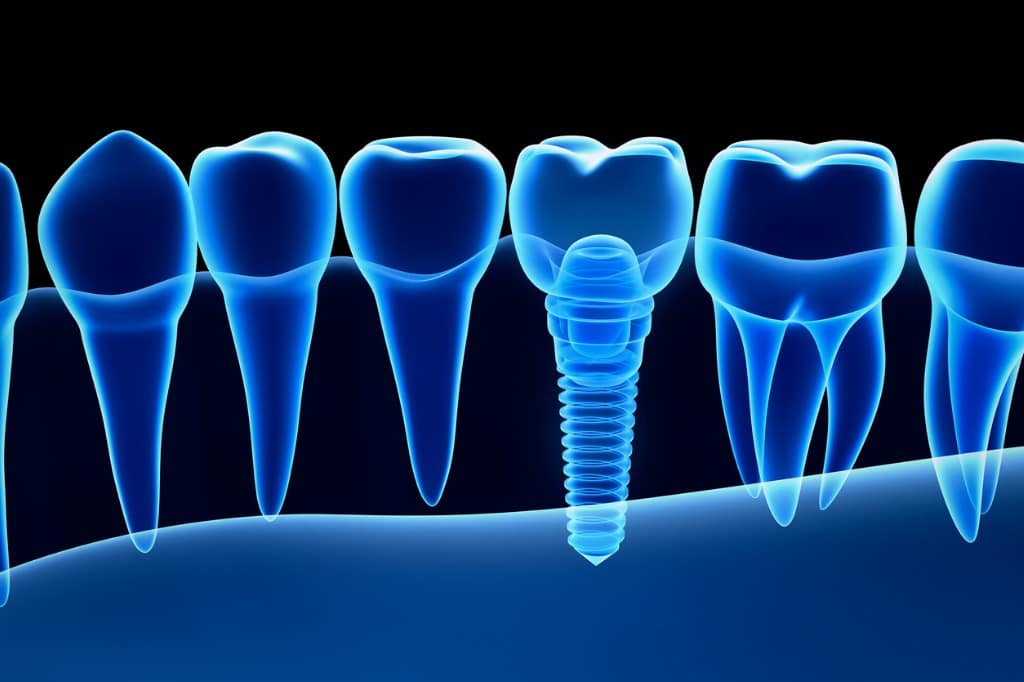What Are Dental Implants?
Dental implants are small titanium fixtures that are surgically placed in the upper or lower jawbone. They replace the root of your missing tooth and provide an anchor for your dental prosthesis (single crowns, bridges, and partial or full dentures). A natural appearance is achieved, and normal chewing and speech are maintained. Dr. Siegelman and his team are proud to offer tooth implants to patients in New York City, Long Island, Westchester County, and the surrounding areas.

Dr. Siegelman is a board-certified dental anesthesiologist and specializes in replacing missing teeth with implants for patients suffering from dental anxiety and patients seeking sleep dentistry.
Advanced Dental Implant Treatment in New York City
At our office in NYC, we are able to integrate a 3D scan of your mouth along with a digital image of your teeth to design a guide for the most precise placement of your dental implants. By using computer-guided surgery, we are able to perform our surgeries quicker and with more ease and accuracy. This allows for less postoperative discomfort and better healing, all while giving you the best possible result.
How Does Conventional Surgery Compare With Computer-Guided Implant Surgery?
Dr. Siegelman is a big believer in staying at the forefront of dental technology. One of the newest advances in utilizing computers to guide the placement of dental implants. Most dentists and oral surgeons are trained to perform implant placement without a computer guide, but Dr. Siegelman thinks the time has come to add this new technological advance for better accuracy and patient comfort.
A 3D cone-beam scan is always the first step to placing an implant. That shows the dentist where the bone has sufficient mass to support an implant. It allows planning of the procedure. But there is still an element of the unknown in the final placement. This is especially true if the patient is missing a series of teeth in an area. Without adjacent teeth to use as guides, there is the possibility of not placing the implant in the optimal location. This can also create the need for longer incisions to gain access to the jawbone.

The planning aspects tend to take more time for conventional implant placement, as well. While the success rate of the implant is basically the same, the patient experience can be impacted by conventional methods.
Contrast that with Dr. Siegelman’s use of computer technology to help plan your implant surgery. These advanced systems take the 3D scans and clearly and precisely show the available bone, the surrounding tissues, and the exact site to safely place the implant. The technology creates an overlay that includes the new dental implants. This allows Dr. Siegelman to visualize and manipulate images of the patient’s jawbone and surrounding tissues when placing the implants. This takes any potential guesswork out of the equation, and this allows for smaller entry incisions and a faster overall procedure.
What Are The Benefits Of Computer-Guided Dental Implant Surgery?
- When the computer takes the 3D bone scan and creates a digital map of the patient’s complete arch, this allows Dr. Siegelman to plot the exact implant locations. This reduces the risk of implant failure.
- Thanks to the pinpoint accuracy, Dr. Siegelman can make smaller, more precise incisions to access the jawbone.
- Patients enjoy faster recovery times due to the smaller incisions used.
- The procedure can be completed in less time because of the accuracy provided by the computer overlay.
- When the computer creates the digital map, it shows the patient’s jawbone, soft tissue locations, root anatomy, and tissue thickness. This is especially helpful when all of the teeth in the dental arch are missing, and there aren’t any landmarks for orientation.
Who Is A Good Candidate For Dental Implants?

The ideal candidate is in good health, does not smoke (smoking inhibits healing), and has healthy gums and enough supporting bone in the jaw. But even when a bone is missing due to resorption, trauma, or disease, a bone graft can often be made prior to starting the implant procedure. However, that being said, a bone graft will add several months to the process.
How successful is dental implant treatment?
Certain conditions such as uncontrolled diabetes, bleeding disorders, a weakened immune system, or cognitive problems that interfere with postoperative care increase the risk of implant failure.
The success rate for this procedure is greater than 90% over 10 years. Complications are rare, but both patient and dentist must take care to avoid infection and inflammation, just as with natural teeth.
Dental implants, like teeth, can also fracture. People who grind their teeth should consider using a mouth guard at night.
What To Expect During The Procedure
Dr. Siegelman will perform a complete examination involving X-rays to determine if you are a suitable candidate for implants. Each patient’s needs are handled individually. A gentle surgical procedure is performed to place the dental implants. After the gums have healed and the implants have integrated with the bone, Dr. Siegelman will attach the crown or bridgework to the top of your new implants. The entire procedure is relatively painless.
Patient testimonial
"Dr. Siegelman and his entire team are amazing. The entire experience from the moment you walk through his doors to the moment you leave is beyond amazing. I have now been a patient for a little over 1 year and don’t plan to leave. If you are worried about coronavirus and going to a dentist, I think his office is more clean and germ-free then anywhere in NYC. He has installed special lights all throughout the office that kill germs, great air circulation, air purifiers everywhere, and some larger scale germ eliminating equipment. The woman who cleaned my teeth was gentle and was constantly checking in on me. If you have dental anxiety I can 100% promise you that you will feel at complete ease and comfort. Thank you to the entire team for making each and every visit of mine a smooth one! Keep up the great work!"
What Issues Can Dental Implants Fix?
Dental implants can replace a single missing tooth without involving healthy adjacent teeth. Implants provide extra support for your existing partial or full denture, alleviating uncomfortable movement. In many cases, dental implants may be placed to support a fixed bridge eliminating the need for a removable partial or full denture. Also, implants minimize gum irritation and pain often associated with removable partials or conventional full dentures.

When Would Computer-Guided Implant Surgery Be Advisable?
This new technology can be particularly advantageous for certain patient situations. For instance, if the patient needs a series of implants to be placed in sequence having computer guidance is a big asset. For replacing an entire arch with same-day implants anchoring a full-arch prosthetic, computer guidance is very important in planning. After all, the patient typically has some extensive bone loss, and accuracy in the placement of the anchoring implants is crucial to avoid implant failure. The accuracy of computer-guided surgery also helps when the patient may have existing implants or to avoid nerve issues with existing teeth.
While it’s not necessary for all patients — for instance, replacing a single tooth in an otherwise healthy arch probably doesn’t need a computer guide.
How Long Is The Recovery Period When Dental Implants Are Placed?

A second recovery period follows the placement of the abutment (post) onto the implant base. At this point, the gum tissue needs to settle in around the post before the artificial tooth can be placed to finish the implant. Again, this requires around two weeks.
Some people consider the entire process by which your jawbone grows around and accepts the titanium implant as “recovery,” but that’s not the case.
Other than these two periods for gum healing, you can eat normally and without any pain while we wait for the jawbone to integrate the implant.
Is Getting A Dental Implant Painful?
There is actually very little pain involved with the placement of a dental implant. Other than the two periods to allow the gums to heal discussed above — and these are not overly painful — that’s really about it. Our patients are always surprised afterward at how easy this process was. And they love their new tooth!
Are There Any Disadvantages To Computer-Guided Implant Surgery?
There aren’t any drawbacks to using this new technology for placing dental implants. The increased accuracy and the ability to see everything going on under the outer soft tissue simply makes an already excellent, successful procedure even more so.
Schedule A Consultation
Call our NYC office at (212) 974-8737 with any questions about dental implants. We are proud to serve patients in New York City, Westchester County, Long Island, Rockland County, New Jersey or Connecticut.

